|
 Gallacea scleroderma Gallacea scleroderma
SynonymsHysterangium sclerodermum
Gallacea violacea
Mesophellia scleroderma
Rhizopogon violaceus
BiostatusPresent in region - Indigenous. Endemic
Images (click to enlarge)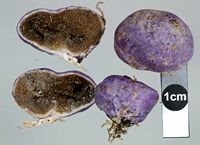
Owner: J.A. Cooper | 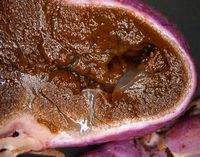
Owner: J.A. Cooper | 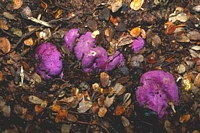
Caption: Peter Buchanan | 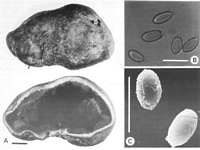
Caption: Fig. 3 Gallacea scleroderma. A, Basidioma exterior and in section (PDD 48939). B,
Basidiospores by bright field (PDD 48939). C, Basidiospores by SEM (PDD 48936). Scale: 1
cm (A), 10 µm (B, C). | 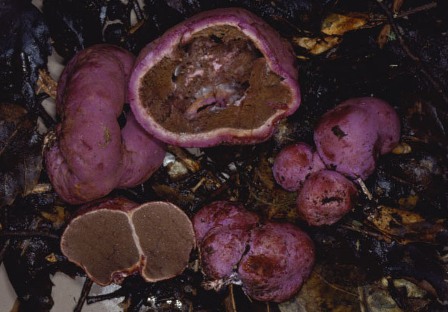
Caption: Gallacea scleroderma, REB 1272
Owner: R.E. Beever | 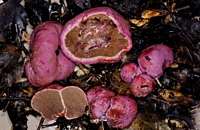
Caption: REB 1272
Owner: Ross Beever |
Article: Castellano, M.A.; Beever, R.E. (1994). Truffle-like Basidiomycotina of New Zealand: Gallacea, Hysterangium, Phallobata, and Protubera. New Zealand Journal of Botany 32(3): 305-328 (http://www.rsnz.org/publish/abstracts.php).
Description: Basidiomata up to 10 cm diam., globose to depressed, larger specimens irregularly
dimpled and grooved, purple to violet when fresh, paler where exposed, bruising brown,
surface tomentose to scaly. Gleba olive brown, deep yellowish brown to dark greyish
brown; locules elongate to irregular, partially filled with spores; developing large
schizogenous cavities up to 2 cm diam. at maturity. Rhizomorphs attached at base, up to
1 mm diam., concolorous with peridium near base, white distally. Columella often poorly
developed, dendroid, translucent when fresh, dark brown when dried. Taste slightly
peppery. Odour nil. Peridium not separable from gleba, a single layer, up to 1500 µm
thick, of hyaline, thin-walled, loosely interwoven, somewhat gelatinised hyphae 7-8 µm
in diam. near gleba, with inflated., isodiametric cells up to 70 um diam. near surface,
clamp connections absent; surface cells yellowish brown with areas of pale violet to
violet pigment (when mounted in KOH) and adherent crystalline particles; near gleba
sterile locules contiguous with subcutis and lined with basidium-like inflated cells,
sometimes with locule wall against gleba fertile. Inflated cells poorly developed in young
specimens. Sutures absent. Trama up to 70 µm thick, of hyaline, thin-walled, mostly
collapsed, subparallel to loosely interwoven hyphae, 2-3 µm diam. in a gelatinised
matrix, clamp connections absent. Basidia elongate. to subclavate, 6-8 µm diam. at apex
c. 3 µm at base x 24-35 µm, hyaline, thin-walled, 4-6-spored. Spores smooth, 8-10.5 x 4-5 µm,
ellipsoid; apex obtuse, base obtuse, with or without a distinct asymmetric sterigmal
attachment up to 2 µm long x 1 µm wide; wall c. 1 µm thick. Utricle absent. Spore
colour in KOH yellow olive singly, brown in mass.
Habitat: Habitat: hypogeous or subepigeous in Nothofagus forests, putatively mycorrhizal with
Nothofagus fusca, N. menziesii, N. solandri, and N. solandri var. cliffortioides. Season:
January through October.
Distribution: New Zealand.
Notes: ETYMOLOGY: Literally from Greek sclero, hard, and derma, skin, but in this context in
reference to the macroscopic resemblance of the basidioma to those of Scleroderma spp.
REMARKS: Gallaeea scleroderma, a common species in Nothofagus forests, is readily
recognised in the field by the purple pigmentation of its peridium. One collection
[WELLINGTON, Tararua Range, Mt Reeves, T.C. Birch, Mar 1931 (PDD 8316, DAOM
116181, OSC)] determined as G. scleroderma on the basis of peridial characters,
including traces of purple pigmentation, approaches G. eburnea in spore size (6-7 x 3.5-4
µm).
Article: Cunningham, G.H. (1934). The Gasteromycetes of Australasia. XVI. Hymenogastraceae, Part I: the genera Rhizopogon, Melanogaster and Hymenogaster. Proceedings of the Linnean Society of New South Wales 59(3-4): 156-172.
Description: R[hizopogon] violaceus Cke. et Mass.
= Hysterangium sclerodermum (Cke.) G.H. Cunn.
|